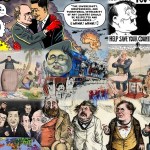Irony and Sarcasm in Editorial Cartoons: Editorial cartoons, with their clever blend of humor and satire, have been a powerful tool for social and political commentary for centuries. Among the various elements that make these cartoons effective, irony and sarcasm stand out as vital components. This article delves into the intricate world of editorial cartoons, unraveling the significance of irony and sarcasm in shaping public opinion, fostering critical thinking, and influencing societal change.
Understanding Editorial Cartoons

Editorial cartoons are succinct visual commentaries that convey a message or critique through humor, satire, and symbolism. Artists use exaggerated caricatures, visual metaphors, and irony and sarcasm to drive their points home. These cartoons are featured in newspapers, magazines, and online platforms, providing a quick and engaging way to address complex issues.
The Power of Irony
Irony is a rhetorical device that involves a gap between appearance and reality, creating a sense of incongruity. In editorial cartoons, irony is a potent weapon, allowing artists to expose contradictions, hypocrisy, and absurdities within political, social, or environmental contexts.

One common form of irony in editorial cartoons is situational irony. Artists often present scenarios where the actual outcome differs from what was expected, highlighting the discrepancy between appearances and reality. For instance, a cartoon depicting world leaders discussing environmental conservation while sitting in a room filled with smoke and pollution subtly exposes the irony in their actions.

Verbal irony is another tool frequently employed in editorial cartoons. Through captions or speech bubbles, artists convey a message opposite to what is stated. This technique adds layers of meaning and encourages readers to reflect on the more profound implications of the cartoon. A cartoon featuring a politician claiming to be a clean energy champion while receiving hefty campaign donations from the fossil fuel industry employs verbal irony to underscore the hypocrisy.
Sarcasm: Cutting Through the Rhetoric
Sarcasm, a form of verbal irony characterized by mock praise or scorn, is a dynamic tool in the arsenal of editorial cartoonists. Cartoonists can use sharp, cutting remarks to challenge authority, expose wrongdoing, and provoke critical thought.

Cartoonists often employ sarcasm to lampoon public figures or institutions that they perceive as failing to adequately address critical issues. For example, a cartoon depicting a corporation proclaiming its commitment to environmental sustainability while simultaneously exploiting natural resources can use sarcasm to emphasize the company’s insincerity.
The Double-Edged Sword: Risks and Rewards
While irony and sarcasm can be powerful tools for social critique, they come with inherent risks. The effectiveness of these devices depends on the audience’s ability to discern the intended message. Misinterpretation may lead to confusion or backlash, undermining the cartoonist’s efforts.

However, when used skillfully, irony and sarcasm can engage audiences by encouraging them to think critically about the issues presented. The humor inherent in these techniques makes complex subjects more approachable, fostering a connection between the audience and the message.
Environmental Advocacy: A Prime Canvas
One of the pressing issues that editorial cartoonists frequently address is environmental degradation. The use of irony and sarcasm in cartoons addressing environmental concerns is particularly noteworthy, as it adds more depth to the discourse.

Cartoonists often employ irony to highlight the contradictions within environmental policies or the actions of influential figures. For instance, a cartoon showing a government official advocating for clean energy while simultaneously approving environmentally harmful projects underscores the gap between rhetoric and action. The irony serves as a call to scrutinize the sincerity of environmental commitments.

Sarcasm, on the other hand, becomes a powerful tool in critiquing industries and individuals contributing to environmental degradation. A cartoon depicting a corporate executive praising their company for minimal environmental efforts can use sarcasm to lay bare the inadequacy of those actions. The biting commentary challenges complacency and urges a reevaluation of priorities.
The Impact on Public Perception
Editorial cartoons, with their use of irony and sarcasm, play a crucial role in shaping public perception and opinion on environmental issues. By presenting complex topics visually engaging and humorously, these cartoons can reach a broad audience, including individuals who might not be inclined to engage with traditional forms of environmental advocacy.

The wit inherent in irony and sarcasm makes environmental advocacy more accessible and relatable. Cartoons appeal to the audience’s emotions rather than relying solely on statistics and scientific jargon, creating a memorable and impactful experience. This emotional connection can lead to increased awareness, empathy, and a call to action.
While using irony and sarcasm in editorial cartoons is effective, striking the right balance is essential. Too much humor can trivialize serious issues, while excessive severity may alienate the audience. Successful cartoonists walk a fine line, leveraging irony and sarcasm to convey their message without diminishing the gravity of the subject matter.

Moreover, cultural and social contexts play a crucial role in determining the reception of cartoons. What may be perceived as witty in one cultural setting could be misunderstood or deemed offensive in another. Cartoonists must be mindful of these nuances to ensure their message resonates positively with diverse audiences.
Conclusion
The marriage of irony and sarcasm in editorial cartoons transforms these artistic expressions into potent social critique and change instruments. In environmental advocacy, where urgency is paramount, cartoons provide a unique and accessible avenue for conveying complex messages.

As we navigate the challenges of environmental sustainability, editorial cartoons serve as a mirror reflecting the contradictions and hypocrisies that persist. The artful use of irony and sarcasm exposes these issues and invites the audience to question, reflect, and, ultimately, take action.

In a world bombarded with information, editorial cartoons stand out as beacons of wit, guiding us through the complexities of environmental advocacy with humor and insight. Through the clever interplay of visuals and words, these cartoons inspire change, one chuckle at a time.
Read also: Editorial Cartoons and the Power of Visual Puns: A Captivating Blend of Wit and Advocacy
Frequently Asked Questions: The Use of Irony and Sarcasm in Editorial Cartoons
1. What role do irony and sarcasm play in editorial cartoons?
Editorial cartoons use irony and sarcasm as powerful tools to convey messages, critique societal issues, and provoke thoughtful reflection. Irony adds layers of meaning by revealing incongruities, while sarcasm employs a cutting and mocking tone for direct criticism.
2. How do cartoonists employ verbal irony in their work?
Verbal irony is commonly used in editorial cartoons through witty wordplay, clever juxtapositions, and unexpected turns of phrase. Cartoonists may use verbal irony to highlight contradictions, hypocrisy, or unexpected consequences in their commentary.
3. What makes sarcasm a potent tool in editorial cartoons?
Sarcasm, characterized by its sharp and mocking tone, is a direct and impactful criticism. Cartoonists use sarcasm to highlight the absurdity of situations, behaviors, or policies, evoking emotional responses that linger in viewers’ minds.
4. Can you explain how irony is used in environmental advocacy cartoons?
Indeed, an example of irony in environmental advocacy cartoons could be a depiction of a factory emitting pollutants with a sign proclaiming it the “Greenest Place on Earth,” exposing the hypocrisy of environmentally harmful practices.
5. How does sarcasm contribute to critiquing environmental issues in editorial cartoons?
Sarcasm is often employed in editorial cartoons to expose greenwashing, critique policy ineffectiveness, and raise awareness about environmental issues. It is a sharp tool to unmask deceptive practices, scrutinize inadequate policies, and inspire collective action.
6. Do cartoonists use irony and sarcasm to target specific individuals or entities?
Editorial cartoonists often use irony and sarcasm to critique specific individuals, corporations, or policies. These targeted critiques hold entities accountable for their actions, expose inconsistencies, and prompt change.
7. How do irony and sarcasm contribute to the effectiveness of editorial cartoons in conveying messages?
Irony and sarcasm make editorial cartoons memorable and impactful. By cutting through surface meanings and employing a humorous or critical tone, cartoonists engage viewers emotionally and intellectually, encouraging them to reflect on the issues presented.
8. Are there risks associated with irony and sarcasm in editorial cartoons?
While irony and sarcasm can be powerful tools, there are risks of misinterpretation. Viewers may not always grasp the intended message, and there’s a potential for cartoons to be misunderstood or taken out of context. Cartoonists must strike a balance to ensure their messages are clear and compelling.
9. How do editorial cartoonists balance humor and severe commentary?
Achieving a balance between humor and serious commentary is a delicate art. Cartoonists often use wit and satire to make serious issues more accessible, but they must be mindful not to trivialize essential matters. Effective cartoons find a middle ground that entertains while provoking thought.
10. Can irony and sarcasm be used in editorial cartoons across different cultural contexts?
The effectiveness of irony and sarcasm can vary across cultures, as humor and the interpretation of satire are influenced by cultural norms. Cartoonists must be aware of cultural sensitivities and tailor their use of irony and sarcasm to resonate with their intended audience while avoiding potential misunderstandings.
This post was created with our nice and easy submission form. Create your post!




